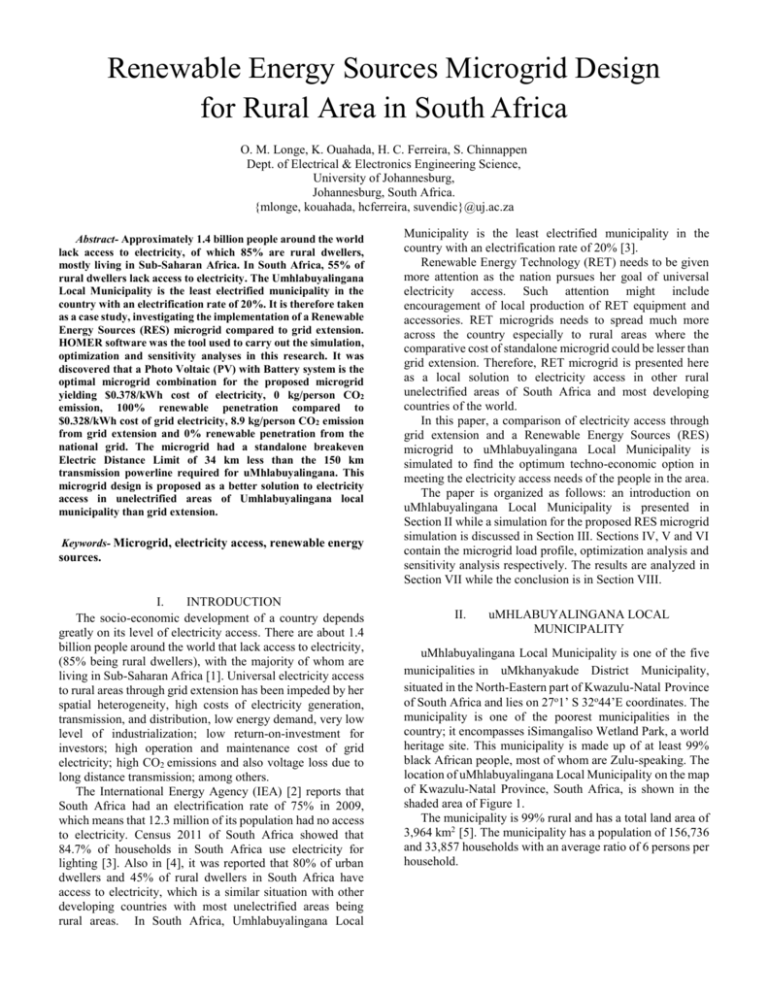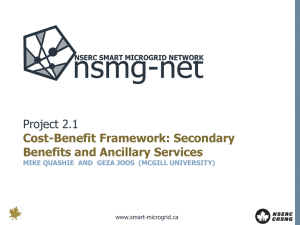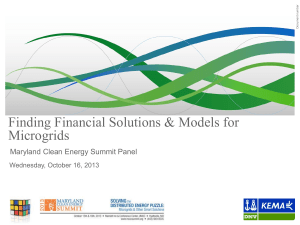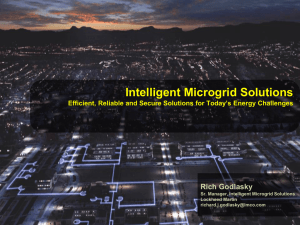1 - University of Johannesburg
advertisement

Renewable Energy Sources Microgrid Design
for Rural Area in South Africa
O. M. Longe, K. Ouahada, H. C. Ferreira, S. Chinnappen
Dept. of Electrical & Electronics Engineering Science,
University of Johannesburg,
Johannesburg, South Africa.
{mlonge, kouahada, hcferreira, suvendic}@uj.ac.za
Abstract- Approximately 1.4 billion people around the world
lack access to electricity, of which 85% are rural dwellers,
mostly living in Sub-Saharan Africa. In South Africa, 55% of
rural dwellers lack access to electricity. The Umhlabuyalingana
Local Municipality is the least electrified municipality in the
country with an electrification rate of 20%. It is therefore taken
as a case study, investigating the implementation of a Renewable
Energy Sources (RES) microgrid compared to grid extension.
HOMER software was the tool used to carry out the simulation,
optimization and sensitivity analyses in this research. It was
discovered that a Photo Voltaic (PV) with Battery system is the
optimal microgrid combination for the proposed microgrid
yielding $0.378/kWh cost of electricity, 0 kg/person CO2
emission, 100% renewable penetration compared to
$0.328/kWh cost of grid electricity, 8.9 kg/person CO2 emission
from grid extension and 0% renewable penetration from the
national grid. The microgrid had a standalone breakeven
Electric Distance Limit of 34 km less than the 150 km
transmission powerline required for uMhlabuyalingana. This
microgrid design is proposed as a better solution to electricity
access in unelectrified areas of Umhlabuyalingana local
municipality than grid extension.
Keywords- Microgrid, electricity access, renewable energy
sources.
I.
INTRODUCTION
The socio-economic development of a country depends
greatly on its level of electricity access. There are about 1.4
billion people around the world that lack access to electricity,
(85% being rural dwellers), with the majority of whom are
living in Sub-Saharan Africa [1]. Universal electricity access
to rural areas through grid extension has been impeded by her
spatial heterogeneity, high costs of electricity generation,
transmission, and distribution, low energy demand, very low
level of industrialization; low return-on-investment for
investors; high operation and maintenance cost of grid
electricity; high CO2 emissions and also voltage loss due to
long distance transmission; among others.
The International Energy Agency (IEA) [2] reports that
South Africa had an electrification rate of 75% in 2009,
which means that 12.3 million of its population had no access
to electricity. Census 2011 of South Africa showed that
84.7% of households in South Africa use electricity for
lighting [3]. Also in [4], it was reported that 80% of urban
dwellers and 45% of rural dwellers in South Africa have
access to electricity, which is a similar situation with other
developing countries with most unelectrified areas being
rural areas. In South Africa, Umhlabuyalingana Local
Municipality is the least electrified municipality in the
country with an electrification rate of 20% [3].
Renewable Energy Technology (RET) needs to be given
more attention as the nation pursues her goal of universal
electricity access. Such attention might include
encouragement of local production of RET equipment and
accessories. RET microgrids needs to spread much more
across the country especially to rural areas where the
comparative cost of standalone microgrid could be lesser than
grid extension. Therefore, RET microgrid is presented here
as a local solution to electricity access in other rural
unelectrified areas of South Africa and most developing
countries of the world.
In this paper, a comparison of electricity access through
grid extension and a Renewable Energy Sources (RES)
microgrid to uMhlabuyalingana Local Municipality is
simulated to find the optimum techno-economic option in
meeting the electricity access needs of the people in the area.
The paper is organized as follows: an introduction on
uMhlabuyalingana Local Municipality is presented in
Section II while a simulation for the proposed RES microgrid
simulation is discussed in Section III. Sections IV, V and VI
contain the microgrid load profile, optimization analysis and
sensitivity analysis respectively. The results are analyzed in
Section VII while the conclusion is in Section VIII.
II.
uMHLABUYALINGANA LOCAL
MUNICIPALITY
uMhlabuyalingana Local Municipality is one of the five
municipalities in uMkhanyakude District Municipality,
situated in the North-Eastern part of Kwazulu-Natal Province
of South Africa and lies on 27o1’ S 32o44’E coordinates. The
municipality is one of the poorest municipalities in the
country; it encompasses iSimangaliso Wetland Park, a world
heritage site. This municipality is made up of at least 99%
black African people, most of whom are Zulu-speaking. The
location of uMhlabuyalingana Local Municipality on the map
of Kwazulu-Natal Province, South Africa, is shown in the
shaded area of Figure 1.
The municipality is 99% rural and has a total land area of
3,964 km2 [5]. The municipality has a population of 156,736
and 33,857 households with an average ratio of 6 persons per
household.
Global Horizontal Radiation
0.8
6,000
0.6
4,000
0.4
2,000
0.2
0
Jan Feb Mar Apr May Jun
Jul Aug Sep Oct Nov Dec
Daily Radiation
uMhlabuyalingana has an electrification backlog that is
mainly attributed to the previous neglect of the area and the
low density settlement patterns which renders electrification
costs high. The area is sparsely settled and, in some instances,
the terrain is very difficult. The limited spare capacity of the
existing electricity network has also been a factor in this
regard. The nodal areas, particularly Manguzi and
Mbazwana, are the most affected by power shortages due to
a relatively high demand for energy in these areas. There is a
general perception that the quality of supply is unreliable and
too intermittent to encourage investor confidence [5].
0.0
Clearness Index
Figure 2: Monthly Daily Radiation for uMhlabuyalingana
10
Wind Speed (m/s)
Figure 1: Location of Umhlabuyalingana Local Municipality
on Kwazulu-Natal Map
1.0
Clearness Index
Daily Radiation (kWh/m²/d)
8,000
Wind Resource
8
6
4
2
0
Jan Feb Mar Apr May Jun
Jul
Aug Sep Oct Nov Dec
Figure 3: Monthly wind speed for uMhlabuyalingana
III.
RES MICROGRID SIMULATION FOR
UMHLABUYALINGANA LOCAL
MUNICIPALITY
This research, using renewable energy sources (RES) for
a microgrid design, can contribute to reduction in emission of
green house gases and preservation of our environment. Wind
and solar energy are the RES components used in this
microgrid design. Hourly wind and solar data for
uMhlabuyalingana were not readily available therefore
locations whose data were available were chosen that fell in
the same solar and wind belts with uMhlabuyalingana.
Therefore, time series (8,760 hours) wind data of Sutherland
was obtained from the Wind Association of South Africa
(WASA) [6] and simulated for uMhlabuyalingana. Also, time
series (8,760 hours) solar data of Lephalale was obtained
from Council for Scientific and Industrial Research (CSIR)
[7] and simulated for uMhlabuyalingana. The simulated
scaled annual average sunshine irradiation and wind speed for
uMhlabuyalingana Local Municipality are 5900 kWh/m2/day
and 7.06 m/s respectively. Average monthly radiation and
wind speed for uMhlabuyalingana are shown in Figures 2 and
3.
Due to the variations in the availability of wind and solar
energy resources at different times of the day and year, a
battery is included in the design for storage. Lastly, a diesel
generating plant is also included in the microgrid design as a
back-up in case there is a failure from the above three energy
sources (solar, wind and battery), especially in the winter
months when load is expected to be higher. A
converter/inverter is also included for conversion of
alternating current to direct current and vice versa.
Hybrid Optimization Model for Electric Renewable
(HOMER) software was developed by National Renewable
Energy Laboratory (NREL), U.S.A to assist in the design of
micropower systems and to enhance the comparison of power
generation technologies across a wide range of applications
[8]. HOMER software is used for the simulation and
optimization analyses in this design because it limits the input
complexity, performs fast enough computation using a logic
that is less detailed compared to several other time-series
simulation models being used for micropower systems like
Hybrid2, PV-DesignPro and PV*SOL and even non-time
series simulators like RETScreen [8]. HOMER is also able
to display a ranked optimization result in an increasing order
of total Net Present Cost (NPC), listing in a table the feasible
design options starting with the one with the lowest NPC as
the optimal system configuration. The proposed
uMhlabuyalingana microgrid as simulated in HOMER is
shown in Figure 4.
m
ET nPT
i i E1 E2 E3 ...Em
(4)
i 1
Where n is the quantity of the appliance i in use, Pi is the
power rating of appliance i and Ti is the duration of appliance
i usage.
TABLE I. HOUSEHOLD ELECTRICAL LOAD
Figure 4: Schematic Representation
uMhlabuyalingana Microgrid
of
Proposed
HOMER calculates the output power of the Photo Voltaic
(PV) system, PPV array using equation (1) [8]:
PPV f PV YPV
IT
IS
(1)
Load
Rating
P (kW)
Usage
T (hrs)
Quantity/
household n
Radio
TV
Fridge
Stove
Phone
Bulbs
Iron
Kettle
Fan*
Heater*
0.015
0.040
0.150
1.000
0.010
0.020
1.000
1.000
0.080
1.000
2
5
24
2
2
6
1
2
3
11
1
1
1
1
2
2
1
1
1
1
Energy
E = nPT
(kWh/d)
0.030
0.200
3.600
2.000
0.040
0.240
1.000
2.000
0.240
11.000
*Indicates seasonal loads.
Where fPV is the PV derating factor, YPV is the rated capacity
of the PV array (kW), IT is the global solar radiation (beam
plus diffuse) incident on the surface of the PV array (kW/m2)
and IS is 1 kW/m2, which is the standard amount of radiation
used to rate the capacity of the PV array. The generator’s
fixed cost of energy, cgen,fixed given as [8]:
crep , gen
Rgen
F0Ygenc fuel, eff
(2)
Where is the operation and maintenance (O&M) cost ($/hr),
crep,gen is the replacement cost ($), Rgen is the generator
lifetime (hrs), Ygen is the capacity of the generator (kW) and
cfuel,eff is the effective price of fuel ($/litre). The effective
price of fuel includes the cost penalties, if any, associated
with the emissions of pollutants from the generator. The
marginal energy cost of the generator, cgen,mar is given as [8]:
cgen ,mar F1c fuel ,eff
Daily Profile
100
Load (kW)
cgen, fixed com, gen
Only 3% of a total of 52% economically active population
within the Municipality earns more than $162 per month [5].
It was assumed that the same appliances are owned by all
households and usage was similar for all households. The
basic appliances that constitute the load are shown in Table I.
The average annual daily load profile as simulated by
HOMER for fifty (50) households is shown in Figure 5.
80
60
40
20
0
0
(3)
Also, HOMER assumes that inverter and rectifier capacities
are not surge capacities, but rather continuous capacities that
the device can withstand for as long as necessary.
uMHLABUYALINGANA MICROGRID LOAD
PROFILE
Microgrid analysis of universal electricity access in
uMhlabuyalingana requires time series data also for
household load profile. Daily, seasonal and annual electrical
load profiles were generated and simulated with Hybrid
Optimization Model for Electric Renewable (HOMER). The
total energy consumed, ET by a household is given as:
12
Hour
18
24
Figure 5: Average Daily Load Profile
V.
IV.
6
uMHLABUYALINGANA MICROGRID
OPTIMIZATION ANALYSIS
HOMER was used to simulate different system
configurations to obtain the one that satisfies the specified
technical constraints at the least life-cycle cost (LCC) and
hence the least Net Present Cost (NPC) is obtained. HOMER
calculates the total NPC using equation (5) [8]:
𝐶𝑁𝑃𝐶 =
𝐶𝑎𝑛𝑛,𝑡𝑜𝑡
𝐶𝑅𝐹 (𝑖,𝑅𝑝𝑟𝑜𝑗 )
(5)
Where Cann,tot is the total annualized cost, i is the annual real
interest rate (discount rate), Rproj is the project lifetime and
CRF(i,Rproj) is the capital recovery factor and is given by
equation (7), where N is the number of years:
Optimal System Type
7,000
0.418
0.418
0.398
5,000 0.418
0.418
0.418
0.398
0.398
6,000
0.418
𝐶𝑅𝐹 (𝑖, 𝑁) =
𝑖 (1+𝑖)𝑁
(6)
(1+𝑖)𝑁 −1
System Types
PV/Battery
Wind/PV/Label/Battery
Superimposed
4,000
5
6
7
8
9
10 Levelized COE ($/kWh)
Wind Speed (m/s)
In the overall optimization result displayed, HOMER lists
the feasible system configurations from the most costeffective (least NPC) to the least cost-effective (highest
NPC).
Table II is the tabular result of the summarized
categorized optimization result of the microgrid. The most
optimal feasible combination for the proposed microgrid is
the highlighted first row of Table II, and it is the PV/Battery
combination having the least total NPC and cost of electricity
(COE) of $0.378/kWh and a renewable penetration (or
Renewable Fraction) of 1.00 since the optimal design
comprised only of PV cells and a battery.
Fixed
Primary Load 1 = 500 kWh/d
Diesel Price = $1/L
Grid Capital Cost = $20,000/km
Figure 6: Optimal System Graph for Proposed
uMhlabuyalingana Proposed Microgrid (Minimum values)
Optimal System Type
7,000
0.656
0.534
0.417
5,000 0.656
0.534
0.534
0.417
0.417
6,000
TABLE II. OPTIMIZATION RESULT FOR PROPOSED
uMHLABUYALINGANA MICROGRID
0.656
Microgrid
Generation Mix
Total NPC
($)
COE
($/kWh)
Renewable
Fraction
PV/Battery
PV/DG/Battery
PV/Wind/DG/Battery
PV/Wind/Battery
Wind/DG/Battery
PV/Wind/DG
DG/Battery
Wind/DG
PV/DG
DG
1,220,029
1,240,485
1,562,204
1,732,445
2,416,412
4,555,533
5,391,039
5,950,324
10,178,164
17,591,758
0.378
0.394
0.414
0.459
0.640
1.207
1.428
1.576
2.696
4.661
1.00
1.00
0.93
1.00
0.64
0.51
0.00
0.36
0.00
0.00
VI.
uMHLABUYALINGANA SENSITIVITY
ANALYSIS
The sensitivity analysis was done using HOMER to
investigate the effect of uncertainties or variations in the five
major variables, (namely, average wind speed, average solar
radiation, electric load, fuel price and grid extension cost),
would have on the choice of micropower design. For this
analysis, minimum and maximum values were chosen for the
five variables and the results are shown in Figs. 6 and 7
respectively with the COE superimposed on the plots.
VII.
DISCUSSION
The findings of this research are discussed under the
following:
A. CO2 and Other Greenhouse Gases Emissions: The
Umhlabuyalingana microgrid design showed a renewable
penetration of 1.00 for the optimal design, which implies that
emissions from greenhouse gases such as CO2, Carbon
System Types
4,000
5
6
7
8
Wind Speed (m/s)
9
10
Wind/PV/Label/Battery
Superimposed
Levelized COE ($/kWh)
Fixed
Primary Load 1 = 2,000 kWh/d
Diesel Price = $3/L
Grid Capital Cost = $30,000/km
Figure 7: Optimal System Graph for Proposed
uMhlabuyalingana Proposed Microgrid (Maximum values)
monoxide, unburned hydrocarbons, Particulate matter,
Sulphur dioxide and Nitrogen oxides are 0.00. Hence, this
microgrid is highly safe for human health in
Umhlabuyalingana, compared to the 8.9 kg/person CO 2
emissions and 0.99 kg/kWh from grid extension in South
Africa in 2012 [9].
B. Breakeven Distance for Grid Extension: The breakeven
distance or otherwise called the Electric Distance Limit
(EDL) in this analysis was found to be 34 km as shown in
Figure 8. This implies that it is only comparatively
advantageous to connect uMhlabuyalingana to the traditional
grid provided the distance between the source substation and
uMhlabuyalingana is ≤ 34 km.
Since most of the unelectrified areas in uMhlabuyalingana
are hundreds of km from grid and at such distances, the cost
of grid extension far exceeds the cost of the proposed
standalone microgrid. The national electricity provider,
Eskom in [10] proposed constructing a 132kV powerline in
the rural area of the Jozini and uMhlabuyalingana
Municipalities as well as two associated 132/22kV
substations in the uMhlabuyalingana Municipality on the
Makhathini Flats. The proposed transmission powerline will
cover a distance of approximately 150 km and have a
servitude width of 32m, which will in turn be more expensive
(higher total NPC) than the proposed ULM microgrid.
6
1.8
Breakeven Electric Distance Limits
x 10
Grid Extension
Standalone
1.6
Net Present Cost ($)
1.4
1.2
1
0.8
0.6
0.4
0.2
0
5
10
15
20
25
30
35
Grid Extension Distance (km)
40
45
50
increase education levels and opportunities and positively
influence the municipality towards a better tomorrow.
The long-term feasibility of off-grid depends on other
factors such as availability of repair facilities, availability of
maintenance personnel, communal influences etc, which
were not considered in this report.
It is hereby proposed to always carry out techno-economic
analysis such as this for any rural unelectrified area in the
world, especially in developing countries, before extending
grid there so that the cost is optimized both for the utility
provider and consumers.
Further work to improve the RES microgrid include
research into how the high cost of battery can be reduced for
the microgrid, a real time control over demand and generation
and also better energy policy proposals for decision makers
in the energy industry of South Africa and other developing
nations.
Figure 8 Graph Showing Electric Distance Limit (EDL) for
Proposed uMhlabuyalingana Microgrid
Susanto [11] reported the cost of a single wire earth return
(SWER) to be $18,544/km. The average cost of grid
extension in Sub-Saharan Africa has been estimated by [12]
as $20,000/km for an 11 kV line cost only. Adding other
required electrification components increases the total
estimate to $25,000/km. The cost of extending the grid to
mountainous areas is generally higher than regions with good
terrains and Umhlabuyalingana having some areas with very
difficult terrain may cost more.
VIII.
CONCLUSION
This study has shown that for an unelectrified locality like
Umhlabuyalingana local municipality, a stand-alone
microgrid is an optimum solution to bring electricity access
to rural areas. The best option found out in this research is the
PV/Battery microgrid for Umhlabuyalingana where the PV
system would generate all the energy production. The cost of
energy to the consumers at the least NPC was $0.378/kWh
compared to the cost of $0.328/kWh if the area is to be
connected to the grid. This difference of $0.05/kWh COE is
an advantage to a potential commercial provider of the
microgrid as the Renewable Energy Feed-in-Tariff (REFIT)
of the government would yield a comparative long-term
advantageous COE less than grid COE and total NPC. Hence,
this RES microgrid would be a more cost effective option.
Also, its 100% renewable penetration means 0 kg/person CO2
emission compared to the general average of 8.9 kg/person
CO2 emission in South Africa. The extension of the existing
electrical grid to rural areas is not always the best option
considering the estimated capital cost of grid extension of
about $25,000 per km, which can be higher for a difficult
terrain like uMhlabuyalingana Local Municipality. With the
implementation of the microgrid, transmission losses
associated with grid extension would also be eliminated.
The population of uMhlabuyalingana is very young with
44% younger than 15, and 77% are younger than 35 years old.
Hence, electricity access will lead to youth empowerment,
IX.
ACKNOWLEDGEMENT
This work is based on the research supported in part by the
National Research Foundation of South Africa (UID 85884).
REFERENCES
[1]
[2]
[3]
[4]
[5]
[6]
[7]
[8]
[9]
[10]
[11]
[12]
IEA, Energy Poverty – How to make Modern Energy Access
Universal? International Energy Access / Organisation for
Economic Co-operation and Development (IEA/OECD), France.
2010.
WEO, New Electricity Access Database, World Energy Outlook,
IEA 2011, www.worldenergyoutlook.org. Retrieved 26/01/2013.
2011.
Statistics South Africa, 2012. Provinces at a Glance,
www.statssa.gov.za. Retrieved 14-12-2012.
CSIR, eThekwini Municipality, North West University, Riso
Technical University of Denmark, SANERI and University of
Witwatersrand, South Africa, “Final Draft Version on Modular
Form of Electrification in Rural Communities in South Africa,
Research on concepts and application of ICT with pre-feasibility
study at eThekwini Municipality”. 2010.
uMhlabuyalingana Local Municipality, “Final Draft- Integrated
Development Plan 2010/11”. 2010.
WASA, Butterworth Wind Data, www.wasadata.csir.co.za.
Retrieved 18-01-2013. 2010.
CSIR, Bethlehem Solar Irradiation Data, www.csir.co.za.
Retrieved 18/01/2013. 2005.
Lambert, T., Gilman, P. and Lilienthal, P., “Micropower System
Modelling with HOMER, Integration of Alternative Sources of
Energy”, John Wiley & Sons Inc., pp 379 – 415. 2006.
Eskom, “Eskom Environmental Indicators – Integrated Report
2012”,
Eskom
Holdings
SOC
Limited,
pp
96,
www.pads.eezeepage.co.za. Retrieved 15/02/2013. 2012.
Eskom and SRK Consulting Engineers and Scientists, “Proposed
Candover-Mbazwaza-Gezisa Project”, 2012.
Susanto J., “Limits of grid extension in the Lao PDR: A financial
perspective”, Journal of Humanitarian Engineering, Vol. 1 No 1,
pp 27 – 38, 2012.
Deichmann, U. Meisner, C., Murray S. and Wheeler D. 2010. The
Economics of Renewable Energy Expansion in Rural SubSaharan Africa, Policy Research Working Paper 5193, The
World Bank Development Research Group Environment and
Energy Team January 2010.






